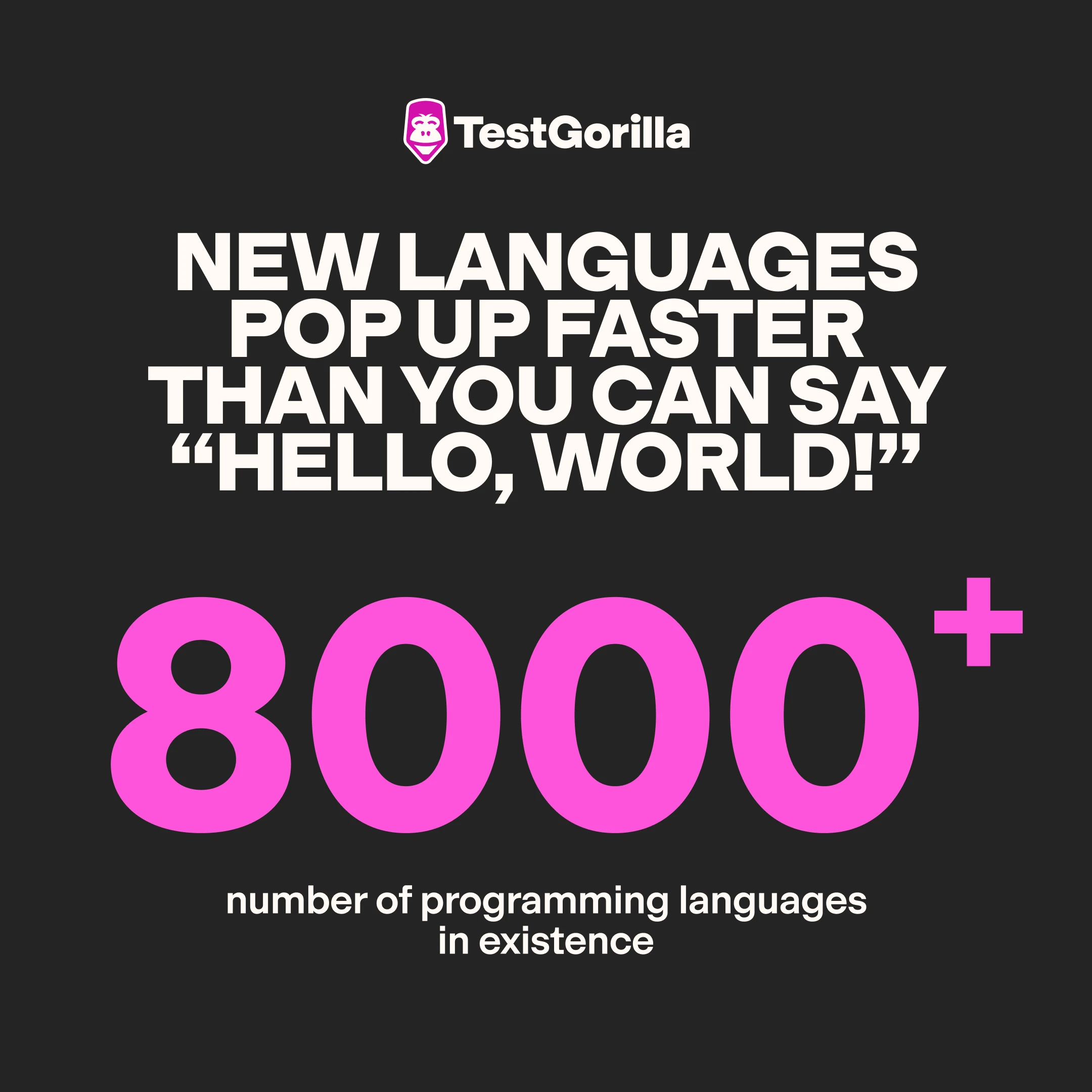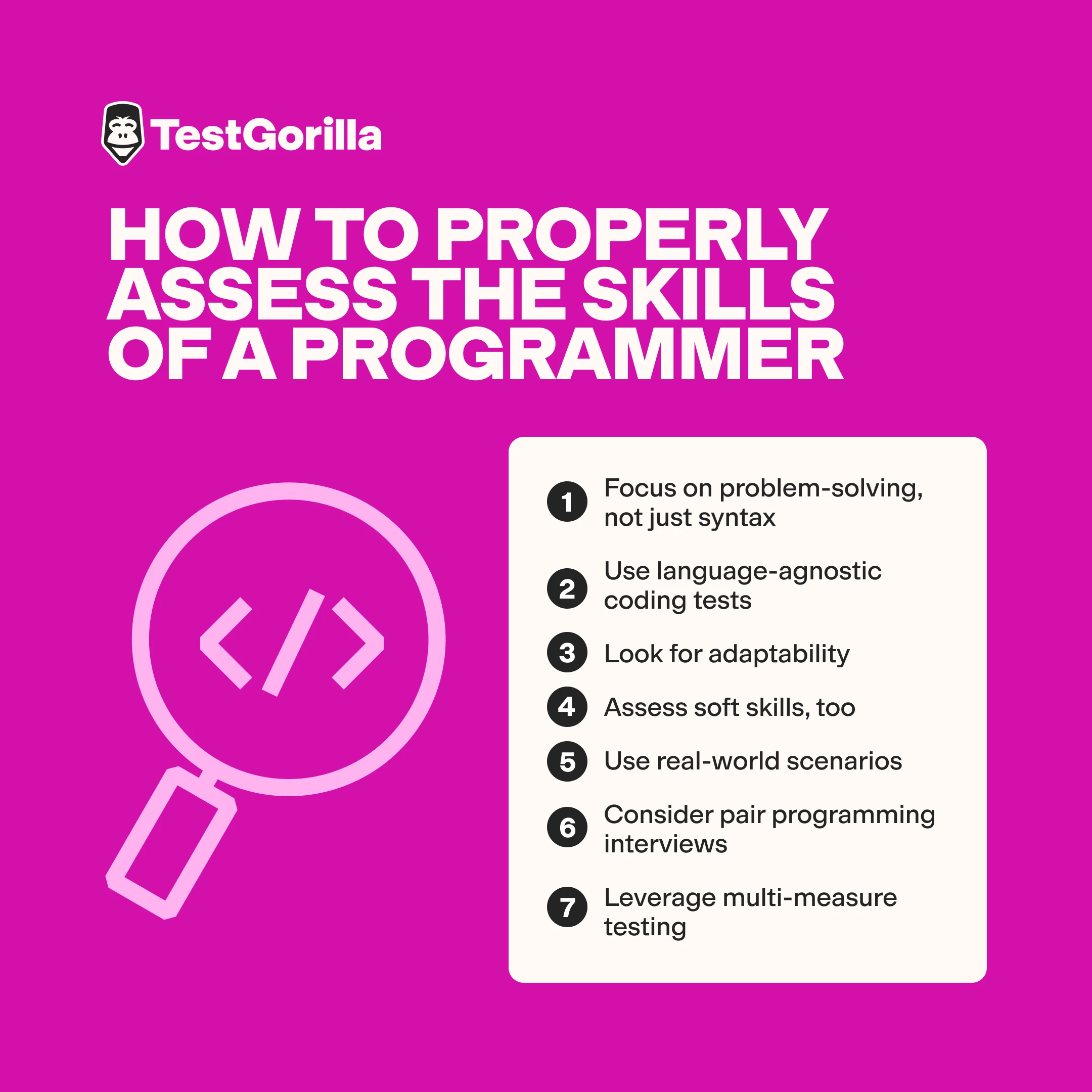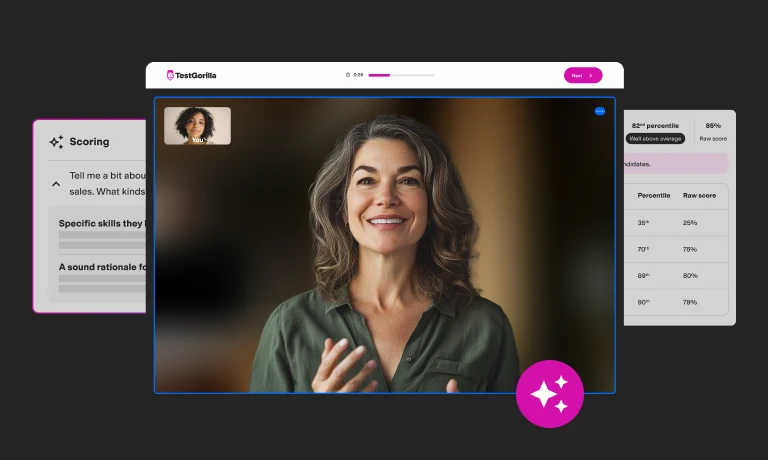There are more than 8,000 programming languages in existence. Shocking, no? But don't be intimidated – you don't need to master them all to be a coding whiz, and you certainly don't need to understand them all to make good hiring decisions. The secret is knowing which programming languages remain relevant today and which will be used in your projects.
On that note, let's dive in and explore the exciting world of programming languages, shine a light on the crowd favorites, and discover how to spot top coding talent.
Key takeaways
There are 8,000+ programming languages, but only a handful are industry staples.
Python, C++, Java, C, and C# are currently the most used languages.
Language-agnostic coding tests are useful for finding versatile developers.
How many programming languages are there?
Pinning down the exact number of programming languages isn't easy, as it's a moving target. New languages pop up faster than you can say “Hello, World!” while others fade into obscurity.
We can, however, categorize programming languages into some broad groups:
General-purpose languages: These are the heavy hitters like Python, Java, and C++. There are about 50 to 100 of these versatile languages, and they've found wide usage in almost all industries.
Specialist languages: These are tailored for specific tasks or industries. For example, SQL is a language used for databases, and R is used for statistics. There are hundreds of these specialist languages.
Esoteric languages: Created for fun or to prove a point, some languages aren't meant for practical use. For example, GolfScript is a proof-of-concept language designed for extreme brevity while sacrificing readability. Another example, Shakespeare, is a language where code resembles Shakespearean plays! There are thousands of these quirky languages.
Outdated languages: Lots of languages have come and gone over the years. They're not in active use, but they're part of coding history. COBOL, for example, saw popular usage in the finance industry between the 1960s and 1980s. Another largely defunct language is ALGOL, which was extensively used in the 1960s and 1970s in academic and research settings. These languages paved the way for those we more commonly use today.
Variations: Many languages have different versions with slight tweaks, which some consider effectively separate languages. For example, JavaScript inspired the creation of TypeScript, which introduces static typing. Another example is Visual Basic, which evolved into VB.NET. The point at which a language can be considered new is up for debate.
Add all these up, and you get the jaw-dropping figure of 8,000+ (The Historical Encyclopedia of Programming Languages lists precisely 8945). However, only a fraction of these are actually used in the real world.
Why are there so many programming languages?
Different problems need different tools. Just like you wouldn't use a sledgehammer to hang a picture frame, you wouldn't use JavaScript to control a spacecraft (hopefully).
Each language has its strengths. For example:
Python is great for beginners and data analysis.
C++ is the go-to for high-performance applications.
JavaScript powers interactive web experiences and is essential for front-end development.
Rust is gaining ground in system programming – for example, operating systems, game engines, and file systems.
Perl, meanwhile, is perfect for businesses looking to automate business-critical workflows and maintain complex legacy systems. (Need a Perl-proficient developer? Take a look at our tricky Perl interview questions.
New languages emerge to solve new problems or to tackle old problems in better ways.
While the vast set of computing languages is fun to play with, in reality, a single developer will only use a handful in their day-to-day work. Being a good developer isn't about knowing every language under the sun – it's about understanding programming concepts and being able to pick up new languages quickly when you need to.
That's why, when you're hiring developers, you shouldn't get hung up on specific languages. Instead, focus on finding people who can think like programmers, solve problems efficiently, and adapt to new languages and frameworks.
The best insights on HR and recruitment, delivered to your inbox.
Biweekly updates. No spam. Unsubscribe any time.
What are the most popular programming languages?
So, if we don't need to know every programming language, which ones are worth paying attention to? To find out, let’s look at the languages that are in active use today. These are also the languages you'll likely see in job listings or use in your projects.
The TIOBE Programming Community Index is like the Billboard Hot 100 for programming languages. It's updated monthly and bases its ratings on the number of skilled engineers worldwide, third-party vendors, and courses available for each language.
Here are the current most popular programming languages at time of writing according to the TIOBE Index:
Python: The Swiss Army knife of programming, it's user-friendly and versatile and used for everything from web development to artificial intelligence. Imagine it as the English of programming languages – widely used and relatively easy to learn.
C++: The speed demon of programming languages, it's the go-to for high-performance applications like video games, trading systems, and operating systems. When every microsecond counts, C++ delivers.
Java: Known for its “write once, run anywhere” capability, it works on a wide range of platforms. It's a favorite for enterprise software and Android app development.
C: Over 50 years old now, C is the grandfather of many modern programming languages. It's low-level and fast and often found in operating systems and embedded systems.
C#: Microsoft's pride and joy. It's widely used for Windows applications and game development with Unity.
JavaScript: The language that makes the web come alive, turning static web pages into interactive experiences. Without JavaScript, the internet would be a lot less exciting.
Visual Basic: Another Microsoft creation, Visual Basic is known for its simplicity. It's often used for developing Windows applications and Office macros. It's the programming equivalent of a starter kit.
Go: Google's contribution to the programming world. Designed for simplicity and efficiency, it's making waves in cloud and network services.
SQL: The language of databases. It helps manage and query vast amounts of data. In the age of big data, SQL remains an important language.
Fortran: First developed in 1958, Fortran is one of the oldest programming languages still in active use. It's the go-to for scientific and numerical computing. In the programming world, Fortran is like a specialized tool for complex mathematical operations.
It’s important to note that popularity doesn't always mean a language is the best fit for your project or team. Each language has its pros and cons. For instance, Python might be great for whipping up a quick prototype, but C++ could be the better choice for that resource-hungry application you're building.
That's why, when hiring programmers, you should look beyond the languages they list on their resume. You want to find people who can think on their feet, solve problems, and pick up new languages quickly.
New programming languages
Let's not forget about the programming language up-and-comers. Languages like Rust, Kotlin, and TypeScript are gaining traction fast, addressing pain points in existing languages and bringing new capabilities to the table.
Rust: Making waves in system programming with a focus on memory safety and concurrency.
Kotlin: Becoming a favorite for Android development, it offers a more concise syntax than Java.
TypeScript: Adding strong typing to JavaScript, TypeScript makes it easier to build and maintain large-scale applications.
Swift: Apple's modern language for iOS and macOS development, it’s designed to be safe, fast, and expressive.
Dart: Used with Flutter for cross-platform mobile development, it’s gaining popularity for its simplicity and performance.
Keeping an eye on these rising stars (and the people who can code in them) can give you an edge in the tech talent race.
How to assess programming skills
When it comes time to hire developers, you need to look beyond just language proficiency. TestGorilla's skills-based approach allows you to assess a candidate's overall programming abilities, problem-solving skills, and adaptability.
Multi-measure testing will help you find developers who can contribute effectively to your team, regardless of the specific languages they've used in the past.
Here’s how to properly assess the skills of a programmer:
1. Focus on problem-solving, not just syntax
Sure, knowing a language inside out is great. But what's more important is how a developer approaches problems. Do they have the critical thinking skills to break down complex issues into manageable chunks? Do they write clean, efficient code? These skills translate across languages.
2. Use language-agnostic coding tests
Instead of testing for specific language syntax, use tests that assess universal coding concepts. This approach lets candidates use the language they're most comfortable with while still demonstrating their skills.
By using language-agnostic coding tests in your hiring process, you open up your talent pool and focus on what really matters: the ability to write good code, solve problems, and contribute to your team.
TestGorilla offers a range of programming skills tests that are language-agnostic. These tests cover everything from basic algorithms to advanced data structures, giving you a comprehensive view of a candidate's abilities.
3. Look for adaptability
The tech world moves fast. The hot language today might be old news tomorrow. That's why you need developers who can learn and adapt quickly. Look for candidates who have experience with multiple languages or who have picked up new technologies on the fly.
4. Assess soft skills, too
Programming isn't just about writing code. It's about working in teams, communicating complex ideas, and managing projects. Don't forget to evaluate these soft skills alongside technical abilities.
5. Use real-world scenarios
Abstract coding challenges are fine, but nothing beats a test based on the real-world problems your team faces. This approach assesses skills while giving candidates a taste of what working with you would be like.
6. Consider pair programming interviews
Pair programming involves the candidate coding alongside one of your team members. It's a great way to see how they think, communicate, and handle feedback in real time.
7. Leverage multi-measure testing
Don't put all your eggs in one basket. Take a multi-measure approach, combining coding tests, interviews, and portfolio reviews to get a well-rounded picture of each candidate.
TestGorilla's platform allows you to combine multiple tests to create a custom assessment. You can include coding tests, cognitive ability tests, and personality tests. This holistic method gives you a comprehensive view of each candidate's potential.
Find your coding superstar with TestGorilla
We've taken a look at the 8,000+ languages out there, with a focus on the heavy hitters. But what's the takeaway for those looking to hire a developer?
First, don't get hung up on specific languages. Yes, experience matters, but problem-solving skills and adaptability are the real MVPs.
Second, embrace diversity. Different languages solve different problems in unique ways. A candidate who's dabbled in multiple languages likely brings a broader perspective to the table.
Finally, focus on skills, not just knowledge. In tech, learning on the fly is more valuable than knowing any single language inside out.
TestGorilla makes the process of finding the right programmers easy. Our coding tests are designed to assess real-world programming skills, helping you find your next coding expert. If you're ready to get started, take a product tour or sign up for our free plan today.
FAQs
How many programming languages are there in total?
There are more than 8,000 programming languages, but only about 50 to 100 are widely used in industry. The exact number is hard to pin down as new languages are created while others become obsolete.
What are the 3 main programming languages?
The three main programming languages, based on popularity and usage, are Python, C++, and Java. These languages consistently rank at the top of programming language indexes due to their versatility, performance, and wide adoption in various industries.
How many C languages are there?
There are primarily four C languages: C, C++, C#, and Objective-C. While they share some similarities, each has its own syntax, features, and use cases. C++ and C# are the most widely used among these.
You've scrolled this far
Why not try TestGorilla for free, and see what happens when you put skills first.




















